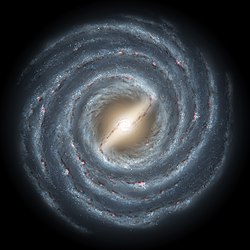Antlia 2
| Galaxie Antlia 2 | |
|---|---|
 | |
| Illustration | |
| AladinLite | |
| Sternbild | Luftpumpe |
| Position Äquinoktium: J2000.0, Epoche: J2000.0 | |
| Rektaszension | 09h 35m 33s |
| Deklination | −36° 46′ 2,28″ |
| Erscheinungsbild | |
| Morphologischer Typ | dE3 |
| Helligkeit (visuell) | 20,6 ± 0,11 mag |
| Helligkeit (B-Band) | −9,03 ± 0,15 mag |
| Winkelausdehnung | 1,27' ± 0,12' |
| Physikalische Daten | |
| Zugehörigkeit | Lokale Gruppe |
| Entfernung | 430000 Lj |
| Masse | (8.8 ± 1.2) × 105 M☉ |
| Durchmesser | 10000 Lj |
| Geschichte | |
| Entdeckungsdatum | 2018 |
| Katalogbezeichnungen | |
Antlia 2 ist eine gravitativ an die Milchstraße gebundene Zwerggalaxie im Sternbild Luftpumpe. Ihre Ausdehnung am Himmel erstreckt sich über 1,27°. Bei einer Entfernung von etwa 430.000 Lichtjahren beträgt ihr Durchmesser somit fast 10.000 Lichtjahre.
Antlia 2 ist eine ultradiffuse Galaxie und unter diesen Galaxien mit Abstand die bislang diffuseste. Sie ist um den Faktor 100 lichtschwächer als die zerstreutesten der bislang beobachteten Galaxien dieser Art.[1]
Antlia 2 wurde 2018 mit Data-Mining-Methoden aus Daten des Gaia-Sternenkatalogs entdeckt. Die Astronomen fanden im Sternbild Luftpumpe (Antlia) eine ungewöhnliche Anhäufung von RR-Lyrae-Veränderlichen, die den entscheidenden Hinweis auf die dahinter verborgene Struktur gab.
Weblinks
- Bruce Dorminey: ESA’s Gaia Spacecraft Spots Ghost Galaxy Lurking In Milky Way’s Outskirts. In: Forbes, 18. November 2018
- G. Torrealba, V. Belokurov, S. E. Koposov, T. S. Li, M. G. Walker, J. L. Sanders, A. Geringer-Sameth, D. B. Zucker, K. Kuehn, N. W. Evans, W. Dehnen: The hidden giant: Discovery of an enormous Galactic dwarf satellite in Gaia DR2. In: Astrophysics. Solar and Stellar Astrophysics. 9. November 2018, arxiv:1811.04082.
Einzelnachweise
- ↑ Daniel Fischer: Geisterhafte Zwerggalaxie Antlia 2: ziemlich nah, riesig – und fast unsichtbar. In: Abenteuer Astronomie, 22. November 2018
Auf dieser Seite verwendete Medien
Caption from NASA: Like early explorers mapping the continents of our globe, astronomers are busy charting the spiral structure of our galaxy, the Milky Way. Using infrared images from NASA's Spitzer Space Telescope, scientists have discovered that the Milky Way's elegant spiral structure is dominated by just two arms wrapping off the ends of a central bar of stars. Previously, our galaxy was thought to possess four major arms.
This artist's concept illustrates the new view of the Milky Way, along with other findings presented at the 212th American Astronomical Society meeting in St. Louis, Mo. The galaxy's two major arms (Scutum-Centaurus and Perseus) can be seen attached to the ends of a thick central bar, while the two now-demoted minor arms (Norma and Sagittarius) are less distinct and located between the major arms. The major arms consist of the highest densities of both young and old stars; the minor arms are primarily filled with gas and pockets of star-forming activity.
The artist's concept also includes a new spiral arm, called the "Far-3 kiloparsec arm," discovered via a radio-telescope survey of gas in the Milky Way. This arm is shorter than the two major arms and lies along the bar of the galaxy.
Our sun lies near a small, partial arm called the Orion Arm, or Orion Spur, located between the Sagittarius and Perseus arms.Autor/Urheber: Credit: G. Torrealba/Academia Sinica, Taiwan; V. Belokurov/Cambridge, UK & CCA, New York, US; based on an image by S. Brunie/ESO, Lizenz: CC BY 4.0
Ghostly Backyard Giant Plays Hide-and-Seek
Astronomers have discovered a large, extremely diffuse galaxy companion to the Milky Way. As big as the Large Magellanic Cloud but 10,000 times fainter, the galaxy has eluded us until now because of its faint, “ghostly” appearance and its hiding place behind the disk of the Milky Way. The discovery was made with the Gaia satellite and archival data from DECam on the CTIO Blanco telescope. Astronomers want to know: is this galaxy an oddball?...or one of many “ghostly” companions yet to be found?
Credit:
G. Torrealba/Academia Sinica, Taiwan; V. Belokurov/Cambridge, UK & CCA, New York, US; based on an image by S. Brunie/ESO

